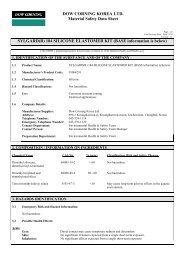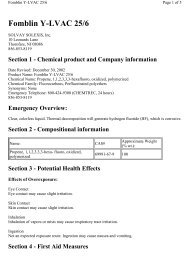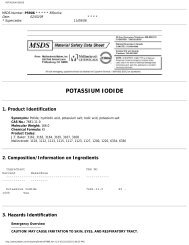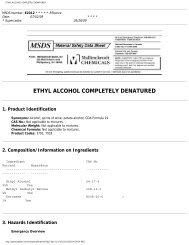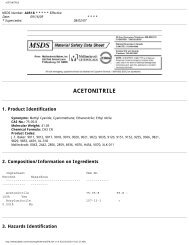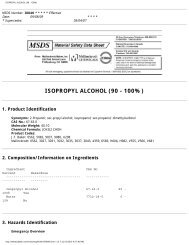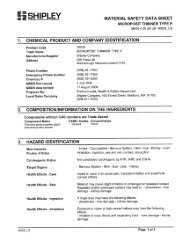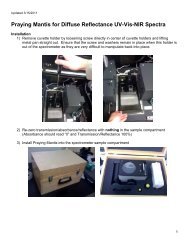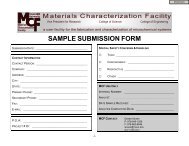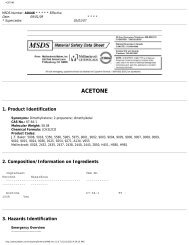Microposit S1805
Microposit S1805
Microposit S1805
- No tags were found...
Create successful ePaper yourself
Turn your PDF publications into a flip-book with our unique Google optimized e-Paper software.
1. CHEMICAL PRODUCT AND COMPANY IDENTIFICATION<br />
Product Code 41200<br />
Trade Name<br />
Manufacturer/Supplier<br />
Address<br />
MICROPOSIT <strong>S1805</strong> PHOTO RESIST<br />
Shipley Company<br />
455 Forest St.<br />
Marlborough, Massachusetts 01752<br />
Phone Number (508) 481-7950<br />
Emergency Phone Number (508) 481-7950<br />
Chemtrec # (800) 424-9300<br />
MSDS first issued 2 July 1996<br />
MSDS data revised 11 June 1998<br />
Prepared By:<br />
Amy C. Nichols<br />
Local Sales Company Shipley Company, 455 Forest Street, Marlboro, MA 01752<br />
(508-481-7950)<br />
2. COMPOSITION/INFORMATION ON THE INGREDIENTS<br />
Component Name<br />
Components in Product<br />
CAS# / Codes Concentration<br />
Diazo Photoactive Compound 1.00 - 10.00<br />
Fluoroaliphatic Polymer Esters 0.01 - 1.00<br />
Mixed cresol novolak resin 10.00 - 20.00<br />
Electronic grade propylene glycol monomethyl 108-65-6 81.00 - 86.00<br />
ether acetate<br />
cresol 1319-77-3 0.01 - 0.99<br />
3. HAZARD IDENTIFICATION<br />
Main Hazards - Irritant - Combustible - Nervous System - Skin - Eye - Kidney -<br />
Routes of Entry<br />
Carcinogenic Status<br />
Target Organs<br />
Health Effects - Eyes<br />
Health Effects - Skin<br />
Health Effects - Ingestion<br />
Liver<br />
Inhalation, ingestion, eye and skin contact, absorption.<br />
Not considered carcinogenic by NTP, IARC and OSHA<br />
- Nervous System - Skin - Eye - Liver - Kidney<br />
Liquid or vapor may cause pain, transient irritation and superficial<br />
corneal effects.<br />
Material may cause slight irritation on prolonged or repeated contact.<br />
Repeated and/or prolonged contact may lead to: - drowsiness - liver<br />
damage - kidney damage<br />
A large dose may have the following effects:<br />
Health Effects - Inhalation<br />
- drowsiness - liver damage - kidney damage<br />
Exposure to vapor at high concentrations may have the following<br />
effects:<br />
- irritation of nose, throat and respiratory tract - liver damage - kidney
4. FIRST AID MEASURES<br />
damage<br />
First Aid - Eyes Immediately flush the eye with plenty of water for at least 15<br />
minutes, holding the eye open. Obtain medical attention if soreness<br />
or redness persists.<br />
First Aid - Skin<br />
Wash skin with water. Obtain medical attention if blistering occurs or<br />
redness persists.<br />
First Aid - Ingestion<br />
Wash out mouth with water. Obtain medical attention.<br />
First Aid - Inhalation<br />
Advice to Physicians<br />
5. FIRE FIGHTING MEASURES<br />
Remove from exposure. If there is difficulty in breathing, give<br />
oxygen. Seek medical attention if symptoms persist.<br />
Treat symptomatically.<br />
Extinguishing Media<br />
Use water spray, foam, dry chemical or carbon dioxide. Keep<br />
containers and surroundings cool with water spray.<br />
Special Fire-Fighting Procedures This product may give rise to hazardous vapors in a fire. Vapors can<br />
travel a considerable distance to a source of ignition and result in<br />
flashback.<br />
Unusual Fire & Explosion Pressure may build up in closed containers with possible liberation of<br />
Hazards<br />
combustible vapors.<br />
Protective Equipment for Fire- Wear full protective clothing and self-contained breathing apparatus.<br />
Fighting<br />
6. ACCIDENTAL RELEASE MEASURES<br />
Spill Procedures<br />
Personal Precautions<br />
Environmental Precautions<br />
7. HANDLING AND STORAGE<br />
Handling<br />
Storage<br />
Contain and absorb using earth, sand or other inert material.<br />
Transfer into suitable containers for recovery or disposal. Finally<br />
flush area with plenty of water.<br />
Wear appropriate protective clothing. Wear respiratory protection.<br />
Eliminate all sources of ignition.<br />
Prevent the material from entering drains or water courses.<br />
Use local exhaust ventilation. Avoid contact with eyes, skin and<br />
clothing. Keep container tightly closed when not in use.<br />
Store in original containers. Store away from sources of heat or<br />
ignition. Storage area should be:<br />
- cool - dry - well ventilated - out of direct sunlight<br />
Other<br />
Proprietary photoresist film contains approximately 2-4% of 2,3,4-trihydroxybenzophenone(THBP), which may<br />
sublime during soft-bake or hard-bake processing. THBP has low acute toxicity (LD50>5g/kg). Contact with<br />
eyes, skin or mucous membranes cause irritation.<br />
To prevent accumulation of THBP on equipment surfaces and ventilation ducts, preventative maintenance<br />
program including regular cleaning should be implemented. Wipe surfaces using an appropriate cleaning<br />
solvent when possible. Provide adequate general or local exhaust ventilation during the cleaning process. In<br />
situations where this is not possible or where solvent or dust concentrations become excessive, use an air<br />
purifying respirator with an organic vapor/toxic particulate cartridge. When cleaning residual THBP, wear<br />
protective gloves and adequate protective clothing to prevent skin contact. Practice good personal hygiene to<br />
prevent accidental exposure. Clean all protective clothing and equipment thoroughly after each use.<br />
8. EXPOSURE CONTROLS/PERSONAL PROTECTION<br />
Occupational Exposure Standards
Electronic grade propylene Manufacturer recommends 30ppm 8h TWA and 90ppm 15 min<br />
glycol monomethyl ether acetate STEL.<br />
cresol<br />
ACGIH: TLV 5ppm (22mg/m3) 8h TWA. OSHA: PEL 5ppm<br />
(22mg/m3) 8h TWA. UK EH40: OES 5ppm (22mg/m3) 8h TWA. Can<br />
be absorbed through skin.<br />
Engineering Control Measures Engineering methods to prevent or control exposure are preferred.<br />
Methods include process or personnel enclosure, mechanical<br />
ventilation (local exhaust), and control of process conditions.<br />
Respiratory Protection Respiratory protection if there is a risk of exposure to high vapor<br />
concentrations. The specific respirator selected must be based on<br />
the airborne concentration found in the workplace and must not<br />
exceed the working limits of the respirator.<br />
Hand Protection<br />
Butyl rubber gloves.<br />
Eye Protection<br />
Body Protection<br />
Chemical goggles.<br />
Normal work wear.<br />
9. PHYSICAL AND CHEMICAL PROPERTIES<br />
Physical State<br />
Color<br />
Odor<br />
Viscous liquid<br />
Red<br />
Sweet<br />
VOC (g/l) 839.80<br />
Specific Gravity 1.010<br />
pH<br />
Neutral<br />
Boiling Range/Point (°C/F) 145.8/295<br />
Flash Point (PMCC) (°C/F) 40.5-46.1 / 105-115<br />
Explosion Limits (%)<br />
Solubility in Water<br />
Vapor Density (Air = 1)<br />
Evaporation Rate<br />
Vapor Pressure<br />
Lower limit 1.5 at 20 °C. Upper limit 7.0 at 20 C..<br />
Insoluble.<br />
Heavier than air.<br />
Slower than ether<br />
10. STABILITY AND REACTIVITY<br />
Stability<br />
Stable under normal conditions.<br />
Conditions to Avoid<br />
Incompatibilities<br />
Hazardous Polymerization<br />
Hazardous Decomposition<br />
Products<br />
Propylene Glycol Monomethyl Ether Acetate: 3.7 mmHg at 20 °C.<br />
- High temperatures - Static discharge<br />
- Oxidizing agents<br />
Will not occur.<br />
11. TOXICOLOGICAL INFORMATION<br />
Acute Data<br />
Chronic/Subchronic Data<br />
Genotoxicity<br />
Reproductive/Developmental<br />
Combustion will generate:<br />
- carbon monoxide - Carbon Dioxide - phenols - toxic fluorine<br />
compounds - aldehydes - oxides of nitrogen - acrid smoke and<br />
irritating fumes<br />
Propylene Glycol Monomethyl Ether Acetate: Oral LD50 (rat)<br />
8532mg/kg. Dermal LD50 (rabbit) 5000mg/kg.<br />
No data.<br />
It was not mutagenic when tested in bacterial or mammalian<br />
systems.<br />
Developmental effects were seen in laboratory animals only at dose
Toxicity<br />
Additional Data<br />
levels that were maternally toxic.<br />
None known.<br />
12. ECOLOGICAL INFORMATION<br />
Mobility Propylene Glycol Monomethyl Ether Acetate: Koc is 0 - 50.<br />
Persistence/Degradability<br />
Bio-accumulation<br />
Ecotoxicity<br />
13. DISPOSAL CONSIDERATIONS<br />
Product Disposal<br />
Container Disposal<br />
The product is partially or slowly biodegradable. BOD20 greater than<br />
40%<br />
No data.<br />
The product is rated as practically non-toxic to aquatic species.<br />
Tests on the following species gave a LC50 of 161mg/litre: - fathead<br />
minnows<br />
Tests on the following species gave a LC50 of 408mg/litre: - daphnia<br />
Incineration is the recommended method of disposal. Dispose of in<br />
accordance with all applicable local and national regulations.<br />
Labels should not be removed from containers until they have been<br />
cleaned. Empty containers may contain hazardous residues.<br />
Dispose of containers with care.<br />
14. TRANSPORT INFORMATION<br />
DOT Ground:<br />
Not Regulated per 49 CFR 173.150(f)(2)<br />
UN Proper Shipping Name<br />
UN Class<br />
UN Number<br />
UN Packaging Group<br />
N.O.S. 1:<br />
N.O.S. 2:<br />
Subsidiary Risks<br />
Flammable liquid, n.o.s.<br />
(3) Flammable Liquid<br />
UN1993<br />
III<br />
Propylene Glycol Monomethyl Ether Acetate<br />
None.<br />
ADR/RID Substance<br />
CLASS 3 - 31(c)<br />
Identification Number<br />
CERCLA RQ Cresol (100#)<br />
Marine Pollutant<br />
No.<br />
15. REGULATORY INFORMATION<br />
TSCA Listed<br />
Yes<br />
TSCA Exemptions<br />
WHMIS Classification D.2.B B.3<br />
MA Right To Know Law<br />
California Proposition 65<br />
SARA TITLE III-Section 311/312<br />
Categorization (40 CFR 370)<br />
SARA TITLE III-Section 313 (40<br />
CFR 372)<br />
16. OTHER INFORMATION<br />
All components have been checked for inclusion on the<br />
Massachusetts Substance List (MSL). Those components present at<br />
the de minimus concentration have been identified in the hazardous<br />
ingredients section of the MSDS.<br />
This product does not contain materials which the State of California<br />
has found to cause cancer, birth defects or other reproductive harm.<br />
Immediate, delayed, flammability hazard<br />
This product does not contain a chemical which is listed in Section<br />
313 at or above de minimis concentrations.
NFPA Rating- FIRE 2<br />
NFPA Rating- HEALTH 2<br />
NFPA Rating- REACTIVITY 0<br />
NFPA Rating- SPECIAL<br />
Revisions Highlighted<br />
Abbreviations<br />
None.<br />
Flash Point (PMCC) (°C/F)<br />
CAS#: Chemical Abstract Services Number<br />
ACGIH: American Conference of Governmental Industrial Hygienists<br />
OSHA: Occupational Safety and Health Administration<br />
TLV: Threshold Limit Value<br />
PEL: Permissible Exposure Limit<br />
STEL: Short Term Exposure Limit<br />
NTP: National Toxicology Program<br />
IARC: International Agency for Research on Cancer<br />
R: Risk<br />
S: Safety<br />
LD50: Lethal Dose 50%<br />
LC50: Lethal Concentration 50%<br />
BOD: Biological Oxygen Demand<br />
Koc: Soil Organic Carbon Partition Coefficient.<br />
TLm: Median Tolerance Limit<br />
Disclaimer<br />
The data contained herein is based on information that Shipley Company believes to be reliable, but no<br />
expressed or implied warranty is made with regard to the accuracy of such data or its suitability for a given<br />
situation. Such data relates only to the specific product described and not to such products in combination with<br />
any other product and no agent of Shipley Company is authorized to vary any of such data. Shipley Company<br />
and its agents disclaim all liability for any action taken or foregone on reliance upon such data.



